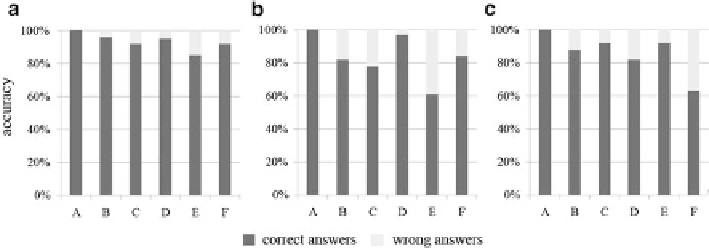Geography Reference
In-Depth Information
Fig. 3 Accuracy of answers monitored for stimuli with different classes to match (A-F) of colour
schemes (a) 4-8-10-8-4, (b) 2-4-6-8-10-12 and (c) 6-8-10-8-6
schemes did proven noticeable improvement, but matching some classes with the
legend was still problematic (Fig.
3b, c
).
Analysing Eye-Movements
In the previous chapter the quantitative evaluation was done in order to find the
most appropriate setting for sequential colour schemes. Analysing eye-movements
can bring more knowledge about what behaviour is behind the process of reading
maps. As it was already mentioned, at the end of the experiment, participants were
asked to recall the procedure of their searching for the information and describe
it. In all cases participants were seeking over the stimulus trying to find lighter or
darker areas and keeping in their memory the order of the one depicted area. In few
cases participants stated, that they matched the depicted area directly with the
legend, without comparing it with other areas in the map.
To find out how different levels of colour distance, or order of classes within the
colour scheme influences the map-users strategy the analyses of eye-movements
regarding specified areas of interest (AOI) was done.
In all experimental stimuli four different AOIs were defined. These AOIs refer to
a region just around the depicted area to be matched with the legend (AOI 1), more
distant region around the depicted area (AOI 2), rest of the map (AOI 3) and the
legend (AOI 4). The proportion of all listed AOIs was the same in all experimental
stimuli.
The hypothesis was, that participants will spend more time in AOI 2 and AOI 3 if
the task is difficult to solve. The more difficult task was given, the more time had to
be spend in order to compare depicted area with others in the map.
In order to find out the interest of experiment participants sum of all fixations
durations over AOIs were analysed. Longer fixation duration could mean difficulty
in extracting information, or the object is more engaging in some way (Eastman
1985
; Poole and Ball
2005
).

